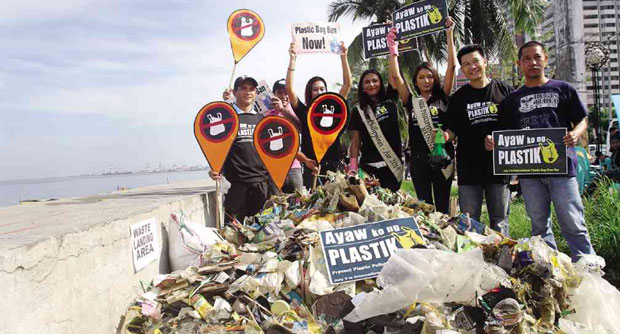
SHORELINE ‘SCAVENGERS’ Miss Earth beauty queens join Thursday’s cleanup drive on the coast of Manila Bay, along with hundreds of volunteers from government agencies and civic groups. JOAN BONDOC
To really make a dent in saving the environment, the ban on plastic bags and wrappers should no longer be just local but national, according to green advocates who scoured the coast of Manila Bay and once again found the shores awash with garbage in what has been an annual and frustrating cleanup campaign.
Volunteers from various government agencies and watchdog groups reported that of the 1,594 liters of trash they collected Thursday from the coastline, from the Manila Yacht Club area to the US Embassy, plastics made up 62 percent. It was up to 75 percent in the last study made in 2010.
“Seeing the enormous volume of plastic bags during today’s discards survey in Manila Bay, we demand from the national government a Philippine-wide plastic ban that will support the growing efforts of local government units in addressing plastic pollution in the country,” said Sonia Mendoza, chair of Mother Earth Foundation, one of the participating groups.
The following cities in the National Capital Region have regulated the use of plastics: Caloocan, Muntinlupa, Las Piñas, Pasig, Quezon, Pasay, Marikina, Mandaluyong, Manila and Makati.
Mendoza stressed: “Plastic discards, especially plastic bags and polystyrene products, continue to be the No. 1 solid waste pollutant of Manila Bay, underlining our common knowledge that plastics are a problem and our tendency to patronize single-use plastic products magnifies this problem.”
The Manila Bay cleanup was held in observance of International Plastic Bag-Free Day. The volunteers also came from EcoWaste Coalition, the Global Alliance for Incinerator Alternatives, Greenpeace and other nongovernment organizations.
A recent UN Environment Programme study titled “Valuing Plastic” estimated that 10 to 20 million tons of plastic find their way into the world’s oceans each year, causing about $13 billion in damage to marine ecosystems. Jeannette I. Andrade